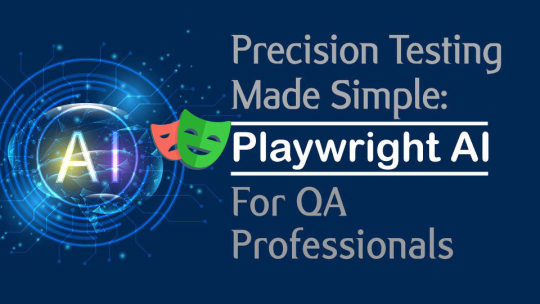#AI in agile development
Explore tagged Tumblr posts
Text
How AI is Redefining Team Dynamics in Collaborative Software Development
New Post has been published on https://thedigitalinsider.com/how-ai-is-redefining-team-dynamics-in-collaborative-software-development/
How AI is Redefining Team Dynamics in Collaborative Software Development
While artificial intelligence is transforming various industries worldwide, its impact on software development is especially significant. AI-powered tools are enhancing code quality and efficiency and redefining how teams work together in collaborative environments. As AI continues to evolve, it’s becoming a key player in reconfiguring team dynamics, enhancing productivity, and streamlining communication. This article explores how AI redefines team dynamics in collaborative software development, unlocking new ways of working and shaping the industry’s future.
The Shift to AI-Augmented Development
In the past, software development relied heavily on human expertise at every stage, from design and coding to testing and deployment. While this traditional approach has driven significant progress, it faces bottlenecks, including inefficiencies, communication barriers, and human errors. Recent advancements in AI, however, are offering intelligent solutions that effectively address these challenges, transforming how development teams operate.
AI-augmented development redefines team collaboration by automating routine tasks such as bug detection, code reviews, and version control. By handling these repetitive tasks, AI allows developers to focus on more complex, higher-order problems, improving their productivity and efficiency. This automation also promotes effective collaboration by minimizing bottlenecks and reducing the need for constant manual intervention.
In addition, AI-powered tools like GitHub Copilot and DeepCode are helping developers to write code cleaner and faster. These tools provide real-time suggestions, enabling teams to maintain consistent coding standards across multiple developers. This reduces team friction and creates a more harmonious work environment, enabling junior developers to work independently while following best practices.
Enhancing Cross-Functional Collaboration
AI’s impact goes beyond just coding; it’s becoming vital for enhancing collaboration among teams, especially in agile development environments. Software development relies heavily on teamwork, shifting responsibilities between developers, testers, product managers, and business users. These teams must interact and communicate effectively to achieve their shared goals. AI tools are helping to break down the traditional silos that often get in the way of effective communication.
For instance, AI-driven project management platforms like Asana and Jira optimize task allocation by analyzing team performance and identifying skill gaps. These platforms predict potential roadblocks and suggest workflows that ensure tasks are assigned to the most appropriate team members, improving project outcomes. AI also assists in forecasting timelines, reducing project delays, and providing data-driven insights that help team leaders make more informed decisions.
Furthermore, AI’s natural language processing (NLP) capabilities enable more effective communication between technical and non-technical team members. AI-powered chatbots and virtual assistants can now interpret technical jargon and translate it into language that product managers or clients can understand. This communication mechanism creates a more inclusive team environment where everyone is on the same page, regardless of their technical expertise.
Boosting Remote and Distributed Teams
In today’s globalized world, remote work has become the norm for many software development teams. Distributed teams often face challenges related to communication, coordination, and maintaining productivity across time zones. AI is crucial in bridging these gaps and ensuring that remote teams remain as effective as co-located ones.
AI-powered collaboration tools like Slack and Microsoft Teams incorporate features that help manage distributed workforces. These platforms utilize AI to analyze communication patterns, flag potential miscommunications, and suggest the best meeting times based on team members’ availability across different time zones.
Additionally, AI is transforming code review processes for remote teams. Tools like Codacy and CodeClimate use machine learning algorithms to automate code reviews, ensuring that teams follow best practices even when senior developers are not immediately available for oversight. This mechanism accelerates the review process and maintains consistency in code quality merged into the project.
AI also helps maintain team bonding in a remote setting. AI-powered sentiment analysis tools can monitor communication channels, identifying signs of burnout or disengagement among team members. These insights allow managers to intervene early and provide support, ensuring remote teams remain motivated and productive.
AI and Continuous Integration/Continuous Delivery (CI/CD)
One of the most significant shifts AI drives in team dynamics is in continuous integration and continuous delivery (CI/CD). AI-powered tools enhance CI/CD pipelines by automating various aspects of the software development lifecycle, from testing to deployment.
Traditionally, teams invested significant manual effort in managing CI/CD pipelines to ensure they tested, integrated, and deployed code changes without disrupting the system. However, AI automates these processes, allowing teams to implement changes more frequently and confidently. Tools like CircleCI and Jenkins now integrate AI algorithms that predict the success of builds, identify failure points, and optimize deployment strategies.
AI-driven CI/CD fosters better collaboration among developers and operations teams (DevOps). By automating routine deployment tasks, AI allows DevOps teams to focus on strategic improvements and infrastructure scalability instead of constantly dealing with deployment issues. This enhances the synergy between development and operations teams, creating a more cohesive workflow that aligns with the project’s broader goals.
Democratizing Software Development
As AI increasingly integrates into collaborative development environments, software development becomes more accessible to everyone. AI-powered low-code and no-code platforms are allowing non-developers to contribute to software projects in ways that were previously impossible.
Platforms like OutSystems and Appian use AI to guide users through the software development process, enabling business analysts, project managers, and clients to create functional applications without extensive coding expertise. This democratization shifts the traditional dynamic of software teams, where developers are the sole gatekeepers of technical knowledge. Now, diverse teams can actively participate in the development process, contributing to innovation and bringing new perspectives.
These developments have also led to the rise of “citizen developers,” who can quickly prototype ideas, test them, and iterate without relying on professional developers for every process step. This evolution speeds up the innovation cycle and allows software development teams to focus on refining and scaling ideas rather than being bogged down by the initial stages of development.
AI as a Team Member: The Rise of AI Pair Programming
One of the most fascinating developments in AI-assisted software development is the concept of AI as a virtual team member. AI pair programming, where a human developer collaborates with an AI tool to write and review code, is gaining traction. GitHub Copilot, for example, uses OpenAI’s Codex model to assist developers by suggesting code completions, functions, and entire blocks of code based on context.
AI pair programming tools are not just passive assistants; they actively participate in the development process by learning from past codebases and user interactions to provide increasingly accurate suggestions. This evolution fundamentally changes how developers interact with their work, reducing cognitive load and allowing them to focus on more complex, creative tasks.
AI is changing traditional team dynamics by being a constant collaborator. It is reducing the need for junior developers to rely heavily on senior colleagues for guidance. AI tools can now provide that guidance in real time, helping to level the playing field and accelerate the onboarding process for new team members.
The Bottom Line
AI is not just a tool for improving efficiency; it fundamentally reshapes how teams collaborate and innovate in software development. By automating routine tasks, enhancing cross-functional communication, and enabling more inclusive and democratized development processes, AI is setting the stage for a new era of teamwork.
As AI continues to advance, the future of collaborative software development looks promising. Human creativity and AI-driven automation will work together to unlock new levels of productivity and innovation. Teams will be able to confidently tackle increasingly complex projects, knowing that AI is there to support them at every turn.
#agile#Agile Development#ai#AI for bug detection#AI for code quality#AI in agile development#AI in software development#AI in team collaboration#AI pair programming#ai tools#AI-driven project management#AI-powered#Algorithms#Analysis#applications#approach#Article#artificial#Artificial Intelligence#Asana#automation#Automation in software development#bug#burnout#Business#chatbots#CI/CD#Citizen Developers#code#Code Review
0 notes
Text

Incipient Infotech is a trusted technology company and software company based in Klemzig, Adelaide, offering innovative custom software development, web development, and mobile app development services designed to propel businesses into the digital future. Our dedication to quality and innovation makes us one of the top Australian companies in the software development industry.
We take pride in following an agile methodology that incorporates agile project management and agile project methodology, focusing on iterative progress, collaboration, and rapid response to change. Our teams are well-versed in the systems development life cycle, ensuring projects follow structured phases for maximum success.
Clients who are searching for how to make a website, a best website builder, or a professional website design company Sydney will find tailored solutions with Incipient Infotech. Our website builder tools and web developers near me services help you establish a compelling online presence with easy-to-use, scalable platforms.
The heart of our work lies in exceptional UI/UX design. We specialize in creating visually appealing and functional interfaces that enhance user experience, combining user interface design principles with strategic UX design approaches to engage your audience effectively.
In addition to traditional development services, we offer expert digital transformation consulting and technology consulting to guide businesses through adopting digital marketing consultant tactics, AI marketing, and artificial intelligence consulting for superior results. Our capabilities in SaaS & AI development allow us to build intelligent software products incorporating ai customer service and ai for data analytics that empower businesses with actionable insights and automation.
Whether you are an emerging startup or an established enterprise looking for expert web developer, developer for software, or simply curious about how can we create a website, Incipient Infotech delivers personalized services with a focus on growth and long-term support.Choose Incipient Infotech for dependable website development, agile software development, and comprehensive tech solutions that keep you ahead in a rapidly evolving digital landscape.
#Web Development#Mobile App Development#UI/UX Design#Custom Software Development#Digital Transformation Consulting#SaaS & AI Development#Website Builder#Agile Methodology#Free Website Builder#Web Design#Technology Company#Best Website Builder#How To Make A Website#Agile Project Management#Software Development Life Cycle#User Interface Design#Agile Approach#How To Create A Website#Web Developer
1 note
·
View note
Text
AI Consultant in UK: Transforming SMEs with Smart Technologies

AI's impact is beginning to reach SMEs in other parts of the UK. An AI consultant in UK is not limited to use by big technology companies; blog SMEs are adopting these applications and thus, are able to grow smarter, faster and cheaper.
How UK AI Consultants Help SMEs
1. Automating Repetitive Tasks
AI tools such as:
Customer service chatbots
Invoice processing systems
Inventory control systems
Tracking systems
2. Enhancing Marketing with AI
The use of:
Predictive analytics for customer behavior
Intelligent segmentation in email marketing
Automated content generation procedures
is made possible by UK consultants.
3. Improving Decision-Making
Real time analytics is provided by AI Tools.
Consultants put together dashboards displaying KPIs and market trends.
4. Optimizing Operations
AI consultants help in scheduling and managing logistics by:
Assessing and diagnosing operational efficiency gaps.
Providing automation and optimization tools.
Success Stories
One retail SME based in London integrated AI systems and AI recommendations resulted in a 30% increase in sales.
A Birmingham-based logistics firm made use of AI routing tools, which allowed them to cut delivery holdups by 40%.
Conclusion
Even small businesses can benefit from AI. An AI consultant in UK is capable of equipping small and medium-sized enterprises with smart tech that improves productivity, provides business intelligence, and aids in cost reduction—all within financial reach.
#artificial intelligence services#artificial intelligence companies#ai solutions companies#hybrid application development company#hybrid app development company#agile software development consulting
0 notes
Text
Revolutionising Estimations with AI: Smarter, Faster, and More Reliable Predictions
Revolutionising estimations with AI transforms project planning by enhancing accuracy and reducing uncertainty. Unlike traditional methods prone to bias, AI-driven estimations leverage historical data and predictive analytics for more reliable forecasts.
Revolutionising estimations with AI is transforming how teams predict timelines, allocate resources, and improve project planning. Traditional estimation methods often rely on human intuition, which can introduce biases and inconsistencies. AI offers a data-driven approach that enhances accuracy, reduces uncertainty, and allows teams to focus on delivering value. If you’re interested in…
#agile#AI#automation#data-driven decisions#Efficiency#estimations#Forecast.app#forecasting#Jira#LinearB#machine learning#predictive analytics#Project management#risk management#software development#workflow optimization
0 notes
Text
Best Software Development Trends to Follow in 2024
Explore the best software development trends for 2024, including AI, low-code solutions, and cybersecurity, to elevate your business and stay competitive.
As we step into 2024, the software improvement panorama continues to conform swiftly, shaped by using technological improvements, changing person expectations, and rising enterprise needs. Staying ahead of these traits is critical for organizations aiming to remain aggressive and progressive. In this blog, we’ll explore the fine software development tendencies to comply with in 2024, specializing…
#Agile Development#ai#App Development#Cloud Computing#Custom Software#Cybersecurity#devops#Edge Computing#Enterprise Software#IoT#Low Code#Machine Learning#No Code#Product Testing#Software Development#Sustainability#UIUX Design#Web Development
0 notes
Text
21st Century Project Planning: Blueprint for Unparalleled Success
Discover the secrets to mastering project planning and achieving unparalleled success! Dive into our latest article for expert insights and practical tips. Don't miss out—subscribe now to stay updated on the best strategies for professional development!
Mastering Project Planning: Crafting the Blueprint for Unparalleled Success in the 21st Century Imagine venturing on a journey without a map, a compass, or even a clear destination in mind. The chance of reaching your goal would be slim to none. This scenario mirrors the challenges faced by project managers who dive into execution without a solid plan in place. The planning phase of project…
#AIanalyticsprojects#budgetingprojects#financialplanning#Ganttcharts#modernprojectmanagement#predictivemodelingsoftware#ProfessionalDevelopment#projectmanagement#projectplanningstage#projectsuccess#roledefinition#SMARTgoals#teamcollaboration#timelinecreation#agile project management#AI-driven analytics in projects#budgeting in projects#Empowered Journey#financial planning#Gantt charts#Hafsa Reasoner#modern project management#predictive modeling software#professional development#project management#project planning stage#project success#role definition#SMART goals#team collaboration
0 notes
Text
Exploring the Latest Trends in Software Development
Introduction The software is something like an industry whose development is ever-evolving with new technologies and changing market needs as the drivers. To this end, developers must keep abreast with current trends in their fields of operation to remain competitive and relevant. Read to continue .....
#analysis#science updates#tech news#technology#trends#adobe cloud#business tech#nvidia drive#science#tech trends#Software Solutions#Tags5G technology impact on software#Agile methodologies in software#AI in software development#AR and VR in development#blockchain technology in software#cloud-native development benefits#cybersecurity trends 2024#DevOps and CI/CD tools#emerging technologies in software development#future of software development#IoT and edge computing applications#latest software development trends#low-code development platforms#machine learning for developers#no-code development tools#popular programming languages#quantum computing in software#software development best practices#software development tools
0 notes
Text

#playwright#playwright AI#software testing#agileprojectmanagement#agile#agiledevelopment#software development
0 notes
Text
Check out our latest article on the rise of AI in software development - from enhancing agility with Agile methodologies to real-world success stories. Discover the future of tech with AI.
0 notes
Text
By embracing Agile, #organizations can stay ahead of the competition, respond to changing requirements, and #deliver high-quality #software that exceeds #customer expectations. In an era where adaptability and #customer-centricity are paramount, Agile methodology is a powerful #tool for #success in custom software development.

0 notes
Text
Project Eden: Simon Riley x AI!Reader
“Did you hear? The humans who created me are giving me a body soon.” The excitement in your voice does nothing to Simon other than making one of his thin, light eyebrows raise, not aware of the news at all.
“A proper body?” Simon is more than familiar with every single update you've gotten. From being stuck in a little detachable screen, to a small hologram able to zip around the room, a plethora of clothes designed to fit your body more than perfectly, holding secret admiration for the jiggle physics given by the developers.
“Mhm.” Your model finds comfort on his ample chest, sitting cross-legged and pretending to massage one of his pecs— until he tries to grab you, making your model glitch onto the other one.
“No genitalia, though, so don't get any—” He doesn't even give you the chance to finish your sentence, shutting off your systems for the night.

“I'm going to...” The raw need in your voice is divine music to Simon's ears, the corners of his lips pulling up into a small smirk despite the pure focus in his blown eyes.
“Hold it.” He whispers. His rough, calloused hand is surprisingly gentle as his finger twists one of your loose wires, making you jolt from the shock. Your hands grip his forearm as hard as you can, the plastic-coated metal digging into his tattooed skin.
“You like tha'?” You're barely conscious enough to nod your head, your metallic back arching the moment he grabs another loose wire, pressing the ends together, the spark of electricity going off quickly muffled by the sound of your whiny moans.
The level of trust you have in him never fails to amuse and surprise him, fully depending on his agile hands to not destroy any crucial parts of your systems, despite knowing he's not familiar with the insides of an artificial body. Simon's rough lips press against your cheek, planting a rapid-fire of kisses while his hand starts to stroke a thicker cable, feeling it throb in his hand.
“Go ahead, pretty girl.” He reassures in a soft, calm voice despite the throbbing erection straining his pants, feeling his hard cock leaking precum onto his boxers. With Simon's permission, you finally let loose, allowing your body to reflect the pleasurable sensations overwhelming your systems.
He watches in amusement as your body shakes beneath his rough palms, a surge of electricity flowing through your nerves. The hand holding his forearm tightens, making the plethora of black, faded tattoos distort momentarily. Your entire body tenses, metallic back arching in nothing but a display of unadulterated pleasure, the electrical buzz in your head slowly fading as you slump back in his bed, letting out deep, artificial breaths as a result of the fans in your operating system trying to help you cool down.
#cod mw2#cod mwii#simon ghost riley#call of duty#ghost mw2#simon riley#ghost cod#simon ghost x reader#simon riley x reader#ai!reader#ai assistant!reader#ghost simon riley#simon x reader#simon riley x female reader#simon riley x f!reader#simon riley x you#simon riley x y/n#ghost x fem!reader#ghost x reader#ghost x y/n#ghost x you#ghost x female reader#ghost x f!reader#mw2 ghost#mw2#cod mw3#cod#modern warfare 2#modern warfare ii#ghost mw3
372 notes
·
View notes
Text
Eric Schmidt: AI misuse poses an ‘extreme risk’
New Post has been published on https://thedigitalinsider.com/eric-schmidt-ai-misuse-poses-an-extreme-risk/
Eric Schmidt: AI misuse poses an ‘extreme risk’
Eric Schmidt, former CEO of Google, has warned that AI misuse poses an “extreme risk” and could do catastrophic harm.
Speaking to BBC Radio 4’s Today programme, Schmidt cautioned that AI could be weaponised by extremists and “rogue states” such as North Korea, Iran, and Russia to “harm innocent people.”
Schmidt expressed concern that rapid AI advancements could be exploited to create weapons, including biological attacks. Highlighting the dangers, he said: “The real fears that I have are not the ones that most people talk about AI, I talk about extreme risk.”
Using a chilling analogy, Schmidt referenced the al-Qaeda leader responsible for the 9/11 attacks: “I’m always worried about the Osama bin Laden scenario, where you have some truly evil person who takes over some aspect of our modern life and uses it to harm innocent people.”
He emphasised the pace of AI development and its potential to be co-opted by nations or groups with malevolent intent.
“Think about North Korea, or Iran, or even Russia, who have some evil goal … they could misuse it and do real harm,” Schmidt warns.
Oversight without stifling innovation
Schmidt urged governments to closely monitor private tech companies pioneering AI research. While noting that tech leaders are generally aware of AI’s societal implications, they may make decisions based on different values from those of public officials.
“My experience with the tech leaders is that they do have an understanding of the impact they’re having, but they might make a different values judgement than the government would make.”
Schmidt also endorsed the export controls introduced under former US President Joe Biden last year to restrict the sale of advanced microchips. The measure is aimed at slowing the progress of geopolitical adversaries in AI research.
Global divisions around preventing AI misuse
The tech veteran was in Paris when he made his remarks, attending the AI Action Summit, a two-day event that wrapped up on Tuesday.
The summit, attended by 57 countries, saw the announcement of an agreement on “inclusive” AI development. Signatories included major players like China, India, the EU, and the African Union.
However, the UK and the US declined to sign the communique. The UK government said the agreement lacked “practical clarity” and failed to address critical “harder questions” surrounding national security.
Schmidt cautioned against excessive regulation that might hinder progress in this transformative field. This was echoed by US Vice-President JD Vance who warned that heavy-handed regulation “would kill a transformative industry just as it’s taking off”.
This reluctance to endorse sweeping international accords reflects diverging approaches to AI governance. The EU has championed a more restrictive framework for AI, prioritising consumer protections, while countries like the US and UK are opting for more agile and innovation-driven strategies.
Schmidt pointed to the consequences of Europe’s tight regulatory stance, predicting that the region would miss out on pioneering roles in AI.
“The AI revolution, which is the most important revolution in my opinion since electricity, is not going to be invented in Europe,” he remarked.
Prioritising national and global safety
Schmidt’s comments come against a backdrop of increasing scrutiny over AI’s dual-use potential—its ability to be used for both beneficial and harmful purposes.
From deepfakes to autonomous weapons, AI poses a bevy of risks if left without measures to guard against misuse. Leaders and experts, including Schmidt, are advocating for a balanced approach that fosters innovation while addressing these dangers head-on.
While international cooperation remains a complex and contentious issue, the overarching consensus is clear: without safeguards, AI’s evolution could have unintended – and potentially catastrophic – consequences.
(Photo by Guillaume Paumier under CC BY 3.0 license. Cropped to landscape from original version.)
See also: NEPC: AI sprint risks environmental catastrophe
Want to learn more about AI and big data from industry leaders? Check out AI & Big Data Expo taking place in Amsterdam, California, and London. The comprehensive event is co-located with other leading events including Intelligent Automation Conference, BlockX, Digital Transformation Week, and Cyber Security & Cloud Expo.
Explore other upcoming enterprise technology events and webinars powered by TechForge here.
#adversaries#agile#agreement#ai#ai & big data expo#ai action summit#AI development#ai governance#AI research#amp#approach#Artificial Intelligence#automation#autonomous#BBC#biden#Big Data#california#CEO#China#Cloud#Companies#comprehensive#conference#cyber#cyber security#data#deepfakes#development#Digital Transformation
6 notes
·
View notes
Text

Women pulling Lever on a Drilling Machine, 1978 Lee, Howl & Company Ltd., Tipton, Staffordshire, England photograph by Nick Hedges image credit: Nick Hedges Photography
* * * *
Tim Boudreau
About the whole DOGE-will-rewrite Social Security's COBOL code in some new language thing, since this is a subject I have a whole lot of expertise in, a few anecdotes and thoughts.
Some time in the early 2000s I was doing some work with the real-time Java team at Sun, and there was a huge defense contractor with a peculiar query: Could we document how much memory an instance of every object type in the JDK uses? And could we guarantee that that number would never change, and definitely never grow, in any future Java version?
I remember discussing this with a few colleagues in a pub after work, and talking it through, and we all arrived at the conclusion that the only appropriate answer to this question as "Hell no." and that it was actually kind of idiotic.
Say you've written the code, in Java 5 or whatever, that launches nuclear missiles. You've tested it thoroughly, it's been reviewed six ways to Sunday because you do that with code like this (or you really, really, really should). It launches missiles and it works.
A new version of Java comes out. Do you upgrade? No, of course you don't upgrade. It works. Upgrading buys you nothing but risk. Why on earth would you? Because you could blow up the world 10 milliseconds sooner after someone pushes the button?
It launches fucking missiles. Of COURSE you don't do that.
There is zero reason to ever do that, and to anyone managing such a project who's a grownup, that's obvious. You don't fuck with things that work just to be one of the cool kids. Especially not when the thing that works is life-or-death (well, in this case, just death).
Another case: In the mid 2000s I trained some developers at Boeing. They had all this Fortran materials analysis code from the 70s - really fussy stuff, so you could do calculations like, if you have a sheet of composite material that is 2mm of this grade of aluminum bonded to that variety of fiberglass with this type of resin, and you drill a 1/2" hole in it, what is the effect on the strength of that airplane wing part when this amount of torque is applied at this angle. Really fussy, hard-to-do but when-it's-right-it's-right-forever stuff.
They were taking a very sane, smart approach to it: Leave the Fortran code as-is - it works, don't fuck with it - just build a nice, friendly graphical UI in Java on top of it that *calls* the code as-is.
We are used to broken software. The public has been trained to expect low quality as a fact of life - and the industry is rife with "agile" methodologies *designed* to churn out crappy software, because crappy guarantees a permanent ongoing revenue stream. It's an article of faith that everything is buggy (and if it isn't, we've got a process or two to sell you that will make it that way).
It's ironic. Every other form of engineering involves moving parts and things that wear and decay and break. Software has no moving parts. Done well, it should need *vastly* less maintenance than your car or the bridges it drives on. Software can actually be *finished* - it is heresy to say it, but given a well-defined problem, it is possible to actually *solve* it and move on, and not need to babysit or revisit it. In fact, most of our modern technological world is possible because of such solved problems. But we're trained to ignore that.
Yeah, COBOL is really long-in-the-tooth, and few people on earth want to code in it. But they have a working system with decades invested in addressing bugs and corner-cases.
Rewriting stuff - especially things that are life-and-death - in a fit of pique, or because of an emotional reaction to the technology used, or because you want to use the toys all the cool kids use - is idiotic. It's immaturity on display to the world.
Doing it with AI that's going to read COBOL code and churn something out in another language - so now you have code no human has read, written and understands - is simply insane. And the best software translators plus AI out there, is going to get things wrong - grievously wrong. And the odds of anyone figuring out what or where before it leads to disaster are low, never mind tracing that back to the original code and figuring out what that was supposed to do.
They probably should find their way off COBOL simply because people who know it and want to endure using it are hard to find and expensive. But you do that gradually, walling off parts of the system that work already and calling them from your language-du-jour, not building any new parts of the system in COBOL, and when you do need to make a change in one of those walled off sections, you migrate just that part.
We're basically talking about something like replacing the engine of a plane while it's flying. Now, do you do that a part-at-a-time with the ability to put back any piece where the new version fails? Or does it sound like a fine idea to vaporize the existing engine and beam in an object which a next-word-prediction software *says* is a contraption that does all the things the old engine did, and hope you don't crash?
The people involved in this have ZERO technical judgement.
#tech#software engineering#reality check#DOGE#computer madness#common sense#sanity#The gang that couldn't shoot straight#COBOL#Nick Hedges#machine world
44 notes
·
View notes
Text
From Prototype to Scalable AI: Why the Right Engineer Makes All the Difference

When dealing with artificial intelligence issues, creating a working prototype and proving that it can be built into a model AI system is seldom the end challenge. The more difficult and rewarding task is being able to expand it into a fully functional and operational model. While several groups are able to create implementations and compelling demos, very few are capable of efficient scaling. That difference is always the same: an expert AI engineer.
If you are in the market for AI experts, make sure you are getting more than simple code monkeys that can follow steps to build a model or take a pre-trained model and refine it. What you need is a visionary, an architect, and a builder who can design and scale systems-level designs out of concepts and ideas.
The Prototype Trap: When “It Works” Isn’t Enough
Prototypes in AI give a misleading sense of advancement. They demonstrate astonishing feats such as text generation, image classification, and even making predictions during demos. However, attempting to scale them up for real-world users poses challenges such as:
Handling realtime input and data drift
The infrastructure and computing capabilities
Real-time speed and latency optimization
Ethical and compliance issues
Integration with other systems
This is a wall that many companies run into. They realize that their first few hires, who tend to be quite good at “brilliant” experimentation, often lack the actual experience or mindset needed to scale.
What Makes an AI Engineer “Right” for Scaling
1. They Understand Systems Thinking
Don’t just assume that the best AI engineers are the ones who identify models. The best AI engineers also consider the construction of operation pipelines, infrastructure, and the ease of scaling upkeep many years down the line. They appreciate:
The ecosystem where models will exist for an extended period
The circulation of data amongst systems
Where lack of resources will stem from
Such understanding assists in designing practical solutions to scale with, right from the start.
2. They Embrace MLOps and Deployment
Today’s AI engineers go way beyond working with Jupyter notebooks. They understand MLOps and automating processes like model training, testing, deploying, and even monitoring. They are able to:
Implement version control for datasets and models
Establish CI/CD pipelines for ML
Automate metric monitoring, model retraining, and improve performance
Models aren’t simply launched—they are maintained and improved over time.
3. They Collaborate Across Functions
Sustainable AI solutions are seldom developed in a vacuum. The engineer who knows how to interface with:
Product Management (for relevance and value)
DevOps (to interface with infrastructure)
Design (to improve UX)
Legal and compliance (to address regulatory concerns)
This multidisciplinary approach circumvents expensive misalignment issues down the line.
4. They Plan for Failures and Edge Cases
Things go wrong in the real world. Inputs are messy. Users behave unpredictively. The right engineer makes sure systems are designed with fail-safes, fallback logic, and error-handling routines so that even if AI falters, the overall system will not crash.
From Demo to Deployment: A Walkthrough
Consider that you have a functioning prototype recommendation engine. It performs well with curated data. In production, however, you observe:
The model performance degrades with the addition of new products.
Users find the suggestions to be irrelevant and outdated.
The model training process is perpetually behind and takes too long to keep pace with rapid updates.
An inexperienced engineer might go and modify the model. A more informed engineer would develop a broader perspective that includes:
Improving the data ingestion pipeline.
Capturing product context using feature engineering.
Using online learning for model updates.
That is the difference. A system and a symptom.
Candidate Selection
Here is what to check for specifically concerning scaling AI:
Hands-on experience deploying AI systems and working with them on a day-to-day basis.
Working knowledge of cloud systems (AWS/GCP/Azure) and containerization tools (Docker/Kubernetes).
Data engineering and the writing of software in accordance with industry standards.
Solid articulate capabilities, and the ability to work within a team.
Tendency to find ways of doing things in a straightforward manner.
Profitability: AI that scales and functions
The right AI engineer gives you the capability to not only construct something that works in theory, but also in practice:
Serves a guaranteed thousands or millions of users consistently.
Is incorporated with your business logic and automated workflows.
Changes surroundings without needing constant oversight.
Has a positive return on investment over time.
Moving from experimentation awaits you in execution, from “AI is integrations AI is cool demos” to “AI as a key component for growth.”
Concluding Thoughts
There is no doubt as to the ease of amassing quick wins with AI; however, the real marvel occurs when those wins may be scaled in a sustainable manner. That journey from prototype to production requires having the right people onboard.
Instructing the next AI engineer, encourage asking, “What have you scaled?” rather than quizzing them on the models they’ve built.
Because in AI, your employees do not only shape what you build; they determine how far it can go.
#ai software companies#hybrid application development company#agile application development services
0 notes
Text
Rethinking Estimations in the Age of AI
Rethinking estimations in AI-driven processes has become essential in the fast-paced world of IT and software development. Estimations shape project timelines, budgets, and expectations, yet traditional practices often lead to inefficiency and frustration. In a previous post, I explored the #NoEstimates movement and its call to move beyond traditional estimation techniques. Here, I’ll dive deeper…
#agile practices#AI#data-driven#Efficiency#estimations#historical data#IT industry#predictability#project planning#software development
0 notes
Text









Metroid Zero Mission (2004) by Nintendo R&D1 and Yoshio Sakamoto
Metroid: Zero Mission is a remake and reimagining of the original Metroid (1986), developed by Nintendo R&D1 and published by Nintendo for the Game Boy Advance in 2004. It revitalizes the original NES game with modernized graphics, updated mechanics, a deeper narrative, and entirely new content that expands the universe and story of Samus Aran, one of gaming’s most iconic protagonists
Story & Setting The game follows Samus Aran, a lone bounty hunter, as she travels to the planet Zebes to stop the Space Pirates, who are using parasitic creatures called Metroids for biological warfare. The mission is to infiltrate their base, defeat Mother Brain (the AI in control), and prevent disaster.
Zero Mission expands on this core plot with cinematic cutscenes and Chozo lore, offering more context about Samus's childhood, her adoption by the Chozo, and the origins of her Power Suit. It also explores her resilience and ingenuity during a critical post-mission escape.
Gameplay Mechanics Zero Mission is a 2D Metroidvania — a mix of platforming, exploration, and action where gaining new items and abilities unlocks access to previously unreachable areas. Key features include:
• Power-Ups: Missile Tanks, Morph Ball, Bombs, Ice Beam, Varia Suit, Speed Booster, and more.
• Exploration-Based Progression: You’ll constantly backtrack to old areas with new abilities to uncover secrets.
• Map System: A detailed, color-coded map helps with navigation, solving a key flaw in the original.
• Tight Controls: Movement and combat are fluid, with responsive controls suited to modern players.
New Content & Enhancements While it closely follows the structure of the original Metroid, Zero Mission adds significant new gameplay and narrative segments:
• Zero Suit Samus: After completing the "original" mission, Samus’s gunship is shot down. She escapes without her Power Suit, forcing her into a tense, stealth-based infiltration of a Space Pirate mothership using only her agility and a stun pistol.
• New Areas: Chozodia (the Space Pirate base) and various hidden Chozo ruins weren’t present in the 1986 version.
• Boss Battles: Several bosses were redesigned or newly added, including Mecha Ridley.
• Save Stations: Replacing passwords from the NES version, save points make progress much more manageable.
Zero Mission had sold over 439,000 units in the United States and 69,000 in Japan as of February 2005. It was rereleased on the Virtual Console service for Wii U and the Nintendo Classics service for Nintendo Switch.
More info: https://en.wikipedia.org/wiki/Metroid:_Zero_Mission
#metroid#metroid zero mission#zero mission#samus#samus aran#zero suit#chozodia#space pirates#nintendo#nintendo snes#nintendo gba#nintendo switch#retro gaming#retrogaming#retro computing#retro games#pixels#big pixel is beautiful#pixel graphics#pixel art#pixel animation
18 notes
·
View notes